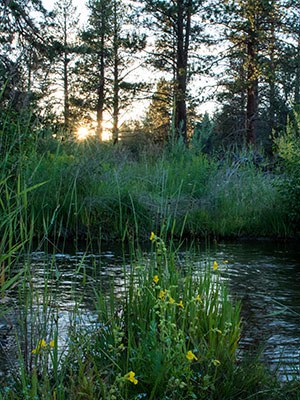The Land Trust initiated Back to Home Waters in 2001 to coordinate protection and restoration efforts supporting the reintroduction of salmon and steelhead into the upper Deschutes basin. Historically, large runs of salmon and steelhead spawned and reared in upper basin tributaries to the Deschutes River, including the Metolius River, Whychus Creek, and the Crooked River and its tributaries. These runs included spring Chinook salmon, summer steelhead, and what was historically one of Oregon’s two sockeye salmon runs.
In 2004, with the Pelton-Round Butte dams up for a new federal operating license, Portland General Electric and the Confederated Tribes of Warm Springs joined forces and committed to restoring fish passage through the project as a component of the new license. Since that time, PGE and the Tribes have invested well over $100 million on new passage facilities to re-establish passage, with plantings of juvenile fish beginning in 2007 and the first successful downstream passage occurring during the winter of 2010.
The dream of bringing these ocean-going fish back to the upper basin has long inspired our effort to protect and restore the freshwater habitat they require at the beginning and end of their life cycle. PGE's and the Tribes' success at re-establishing passage through the dams–-an extraordinary technical challenge–-provides new urgency for our work. We began this work by protecting the largest piece of private land in the Metolius basin, the Metolius Preserve, a project that secured important spawning and rearing habitat for spring chinook and the historic Suttle Lake sockeye run. Spring chinook will also find protected spawning and rearing habitat at Spring Creek, a nearby private 25-acre parcel protected by the Land Trust.
Currently, one of our highest priorities is Whychus Creek, a Deschutes tributary many scientists feel holds the key to re-establishing wild steelhead in the upper Deschutes basin. The Land Trust has undertaken a series of projects (Camp Polk Meadow, Alder Springs, Rimrock Ranch and Whychus Canyon) on lower Whychus Creek with the intent of acquiring land to create a critical mass of high quality habitat that can anchor efforts to bring the Deschutes River’s most iconic species back to their home waters. Our 2012 and 2016 of Whychus Creek at Camp Polk Meadow Preserve and Whychus Canyon Preserve are highly visible example of the kind of coordinated restoration that’s essential for the successful return of steelhead to the upper Deschutes.
Another high priority is the restoration of Ochoco Preserve near Prineville. With 1 mile of the Crooked River, 1/2 mile of McKay Creek, and 1/2 mile of Ochoco Creek, Ochoco Preserve has significant potential for restoring habitat for fish and wildlife. Our hope is to restore some of the natural processes that the Crooked River, Ochoco Creek, and McKay Creek would have had historically. This includes creating more habitat for fish and wildlife and reconnecting the waterways to their historic floodplain. Learn more about the restoration.
Finally another priority is conserving and restoring Priday Ranch. Priday Ranch is a 4,500 acre property north of Madras. It has long been recognized for its outstanding natural values. It includes ten miles of steelhead spawning streams, making it important to the survival of Deschutes River wild steelhead. Learn more about Priday Ranch.
While our conservation and restoration of rivers and streams in Central Oregon is a long-term process that will play out over several decades, our success to date can be traced to the community’s ownership of this effort and to our participation in the Deschutes Partnership. The Deschutes Partnership is a unique collaboration between the Deschutes Land Trust (permanent protection and stewardship of key stream sections), the Deschutes River Conservancy (acquisition of water rights and transfer of water rights back into the stream) and the Upper Deschutes Watershed Council and the Crooked River Watershed Council (watershed planning, restoration, and education). Together, these partner organizations provide the expertise and resources that will enable us to achieve complex and significant progress in caring for our rivers and streams. Our goal is to have water in the creeks, clean gravel beds for fish to spawn in, and productive pool habitat where juvenile fish can rear. The Deschutes Partnership has been lauded as emblematic of “the Oregon way” and an example that can be replicated around the West.
Learn more:
- Whychus Creek restoration at Whychus Canyon Preserve
- The Ochoco Preserve Project


